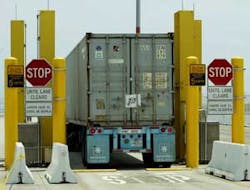California Ports Get Upgrades with Radiation Scanners
LOS ANGELES (AP) - The head of the U.S Border Patrol unveiled radiation detectors to scan incoming ocean cargo for nuclear weapons and dirty bombs, a measure he says will not choke the flow of trade at the nation's busiest port complex.
Customs and Border Protection Commissioner Robert C. Bonner said the 20-foot-(six-meter-) high devices would substantially boost port security at the Los Angeles-Long Beach harbor complex without causing major delays.
"We have to save American lives, but we also have to do it in a way ... that preserves American livelihoods," Bonner said during a visit Wednesday to the ports of Long Beach and Los Angeles.
The dual ports handle more than 40 percent of all cargo shipped into this country, and 80 percent of the imports from Asian manufacturing countries such as China and India.
The federal government has installed about 14 of the monitors, with plans to install a total of 90 by year's end.
Trucks carrying cargo unloaded from ships will pass through the systems, a process that takes a matter of seconds.
If the machines find signs of radiation, the container will get another scan and possibly an inspection by hand-held devices to help identify how much and what kind of radiation is present. That secondary inspection can last 10 minutes or longer.
Should authorities still have trouble identifying the container's contents, data will be sent to a federal research center in Virginia to determine whether the cargo is harmless or contains plutonium or highly enriched uranium, which can be used to produce nuclear weapons.
In the meantime, the container could be isolated instead of closing the terminal.
"We're serious about doing everything we reasonably can to secure this port, "Bonner said.
Nearly 540 radiation portal monitors, which cost approximately $250,000 (euro207,245) each and are federally funded, are being used at seaports and border crossings nationwide, officials said.
About one out of every 100 to 150 containers bears cargo that sets off the scanner, prompting a secondary inspection, officials said. The error rate is about one in 10,000.
Still, terminal operators and shipping companies aren't overly concerned about delays, said Tupper Hull, spokesman for the Pacific Merchant Shipping Association, which represents the ocean carriers and terminals.
"Right now there's a fair amount of confidence that these things work and work well," he said.
